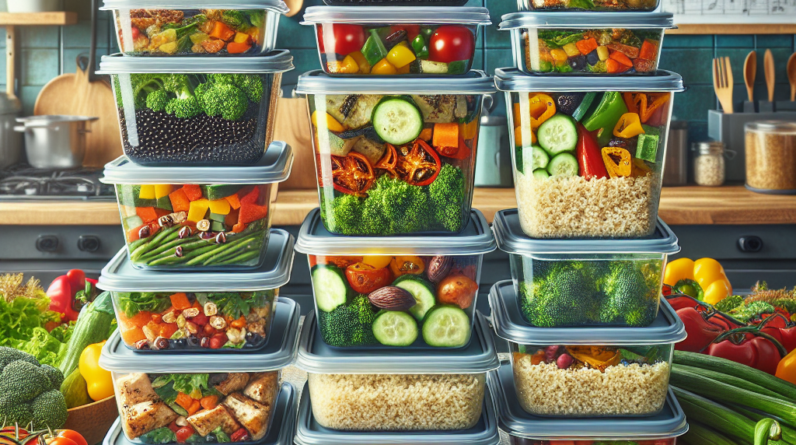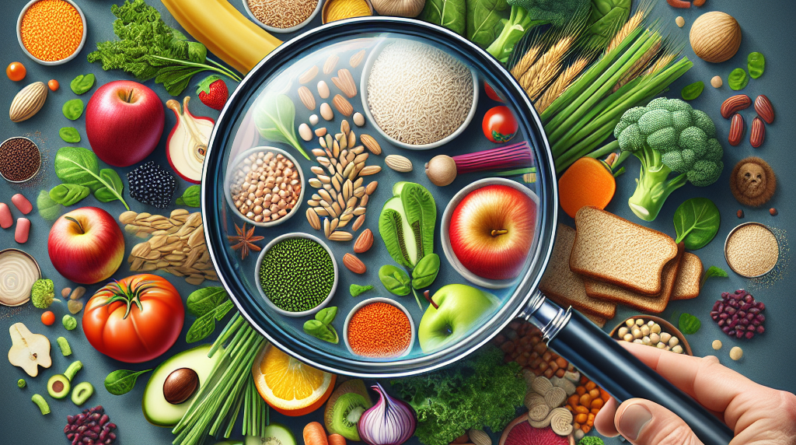
1. Planning Your Meals
Assess Your Week Ahead
Before diving into meal prep, I like to take a quick inventory of my week. Are there any events that will keep me out late? Do I have a lunch meeting or a dinner with friends? Knowing what’s coming helps me plan my meals effectively. It’s totally okay to let the week’s schedule dictate your meal options.
Get a Huge Discount and Bonus! Try for 90 Days Risk Free
I usually jot down my commitments in a planner or use an app. This visual helps me see exactly when I’ll need a quick meal versus when I can take my time. Believe me, having this layout in front of me saves so much stress the day of.
Making a list of what meals fit best into my busy days allows me to embrace the week with confidence. Whether I’m prepping salads for lunch or stews for dinner, having a plan is key.
Choose Your Recipes Wisely
Once my week is mapped out, it’s time to select some delicious, organic recipes that match my schedule. I find that picking a variety of dishes, like a grain bowl, a hearty soup, and quick stir-fries, ensures I don’t get bored eating the same things.
Another pro tip? I always look for recipes where I can use similar ingredients across multiple meals. This not only saves money but also makes shopping a breeze. For example, I might use quinoa for a bowl one day and in a salad the next!
Also, don’t forget to check what you already have in your pantry. Sometimes you can whip up fantastic meals just using what’s lying around, which leads me to my next point—minimizing waste!
Make a Grocery List
With recipes in hand, I create a detailed grocery list. I’m talking everything from the organic veggies to the spices I might need. Writing this down not only keeps me organized but also prevents those “ooh, shiny!” moments at the store.
Another trick I’ve learned is to group my list by sections of the grocery store—produce, dairy, pantry items, etc. This makes shopping so much quicker, especially on those bustling weekends when I feel like I’m competing against everyone else in the grocery aisle!
Lastly, I always like to check for sales or coupons for organic products. I’m all about saving those extra bucks whenever I can, and with meal prep, every little bit helps for the week ahead!
Get a Huge Discount and Bonus! Try for 90 Days Risk Free
2. Batch Cooking Techniques
Pick One Day to Prep
I’ve found it works best for me to dedicate one day a week specifically for meal prep—usually Sunday. It’s like a little ritual where I put on some good music and embrace the kitchen chaos!
Timing is everything, so I try to cook dishes that require varying cook times at the same time. For example, if I’m roasting veggies, I can have a soup simmering on the stove at the same time. Multitasking like a pro!
I also keep an eye on the clock to ensure things don’t overcook. After a couple of meals burned beyond recognition (trust me, it happens), I learned to set timers to stay one step ahead!
Use Quality Containers
Investing in the right containers has been a game-changer. I prefer glass containers because they’re durable and don’t hold onto stains or smells like plastic can. Plus, they’re microwave-safe, which makes reheating so straightforward.
Need a Serious Energy BOOST? Huge Discount Try for 90 Days Risk Free
When storing meals, I like to portion them out into individual servings. This way, when I’m in a rush, I can just grab a container, heat it up, and boom—dinner’s served!
Labeling my containers also helps. I write the date and contents so that there’s no confusion when I’m digging through the fridge mid-week. Trust me, you’ll thank yourself later when you’re not playing the “what’s under here?” game.
Bake and Roast Together
Baking is not just for sweet stuff! I often set my oven to roast vegetables and chicken at the same time, which saves energy and time. While everything bakes to perfection, I’ll prepare other components like grains or salads.
This method also really brings out the flavors. Roasting veggies brings out their sweetness, making your meals that much more satisfying. It’s all about creating delicious, wholesome meals that I can look forward to throughout the week!
Plus, leftovers can easily morph into new meals. That roasted chicken? It can turn into a delicious salad, soup, or wrap. Talk about versatility!
3. Smart Storage Practices
The Right Temperature Matters
After cooking, it’s important to properly store your meals. I always let hot food cool slightly before sealing it in the fridge—as tempting as it might be, putting hot dishes directly into the fridge can raise the overall temperature and spoil other foods.
Future me thanks present me when I remember to store things in shallow containers. This helps food cool faster and keeps everything safer to eat. Sometimes the little things make all the difference!
And for longer storage, freezing is my best friend. Soups, stews, and cooked grains freeze like a charm, so I can have a homemade meal ready at a moment’s notice on those truly busy days!
Organized Fridge and Freezer
An organized fridge really helps, too. I like to keep similar items together—soups on one shelf, cooked grains on another. This way, when I’m in a rush, I can quickly see what’s available without rummaging through everything.
For the freezer, I always write the name and date of each item on the bag. It’s a lifesaver! I never have to wonder if that mystery ziplock contains soup or some regretful science experiment gone wrong.
And, I try to use older items first, keeping the newer ones at the back. This habit cuts down on food waste and helps me keep track of what I have available.
Reheating Techniques
When it’s time to eat, I have a few go-to reheating tricks. For things like rice and grains, a splash of water and a quick microwave zap rehydrates them instantly. Those dry grain dilemmas? Solved!
Good Health Solution is Easier Than Most People Think!
Take a Look for Yourself!
For soups and stews, I like to reheat them on the stove. Not only does it warm them up evenly, but it also brings out all those amazing flavors again. Plus, who doesn’t love the smell of delicious food cooking?
If I’m tossing greens with a warm meal, I’ll give them a quick massage with olive oil and a sprinkle of seasoning. It’s a small step, but it makes a huge difference in bringing a simple dish to life.
4. Utilizing Fresh Ingredients
Add in Fresh Herbs
When I think of elevating my meals, fresh herbs come to mind. They add a pop of flavor and really can change the whole vibe of a dish. I often pick up basil, cilantro, or parsley at the market to sprinkle in right before serving.
Plus, they’re super versatile. You can toss them into a grain bowl, a salad, or even a sauce. I find fresh herbs make my meals feel gourmet, all while being super simple!
Pro tip: If I have too much leftover, I’ll chop herbs and mix them with olive oil. Then, I freeze them in ice cube trays. It’ll be like having a burst of freshness available all week long!
Incorporate Seasonal Produce
Using seasonal produce is not only better for my budget, but it also guarantees that the flavors are vibrant and fresh. Eating what’s in season means I’m getting the best taste while also supporting local farmers.
At the farmers’ market, I often like to ask vendors what they recommend for the week. A little chat often leads me to discover new ingredients I hadn’t thought of before. Not to mention, those fruits and veggies tend to be the freshest of the season!
For meals, I might go for roasted Brussels sprouts in the fall and fresh berries in the summer. Keeping it seasonal keeps my meals exciting and vibrant all year round!
Balance Your Plate
In my meal prep, I strive for balance. I think about including plenty of colorful veggies, whole grains, and a good protein source. Creating a colorful plate not only looks appealing but also checks those nutrition boxes!
By using various textures and flavors, I can prevent any meal from becoming boring. I’m all about merging crisp with creamy, sweet with savory—it makes every bite interesting!
And let’s not forget the snacks! I always keep fruits and nuts on hand for those in-between meal moments. It’s an easy way for me to stay energized and satisfied as I tackle my busy week.
5. Setting Yourself Up for Success
Create a Routine
Having a meal prep routine creates a sense of comfort in my busy schedule. I set a specific time each week just for prep. It’s a boundary I’ve drawn that helps manage my stress and keeps me in control of my meals.
Over time, I’ve come to appreciate this predictable pattern. It’s my little time in the kitchen to unwind and be creative, plus knowing I’ve got meals ready takes a weight off my shoulders.
And as I build this habit, I tease my friends who might not be meal prepping about how easy it is, barely scratching the surface. You really can save money, eat well, and feel good about yourself!
Stay Flexible in Your Planning
Of course, life happens, and that means flexibility is key. I must admit that sometimes my perfectly planned week goes haywire. When that happens, I don’t stress. I adapt, maybe swap a meal or take a night to have a hearty snack instead.
This flexibility works wonders for my mental health. It allows me to focus on what I can control without letting minor setbacks ruin my overall goals for healthy eating.
So, if you have to change up your meal plan midweek? No biggie. Embrace it, figure out what works, and remember—next week’s a fresh start full of new possibilities!
Celebrate Your Success
Lastly, I make sure to celebrate my meal prep victories. After a successful prep day, I enjoy a meal right then and there as a reward for all my hard work. It helps me appreciate the time and energy invested!
Having these meals ready allows me to savor evenings with friends or catch up on a good show without worrying about what I’m cooking last minute. So, I make it a point to acknowledge that accomplishment.
Every week, I treat it like a mini-party for one—with good food, a cozy setup, and a little bit of joy from the act of prepping itself. Because why not? After all, planning and prepping for a busy week is its own victory!
FAQ
1. What types of meals should I prep for a busy week?
It’s great to include a variety of meals! Think grain bowls, soups, salads, and stir-fries. These can often be made in larger batches and stored easily!
2. How do I keep track of what I have in my fridge?
A good approach is to label containers with dates and contents. An organized fridge layout also helps you see everything at a glance!
3. Can I freeze all types of meals?
Most cooked meals freeze well! Soups, stews, and grains are great options. Be cautious with items that contain fresh veggies that don’t freeze well, like salads.
4. How can I make meal prepping enjoyable?
Try putting on your favorite music or a podcast while you prep. Enjoy exploring new recipes and don’t forget to celebrate your successes along the way!
5. What are some tips for staying flexible with my meal prep?
Always have a few quick meal options ready to go—think easy stir-fries or pastas. And remember, if things don’t go as planned, it’s okay to adapt and do your best!








